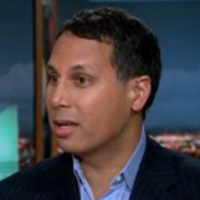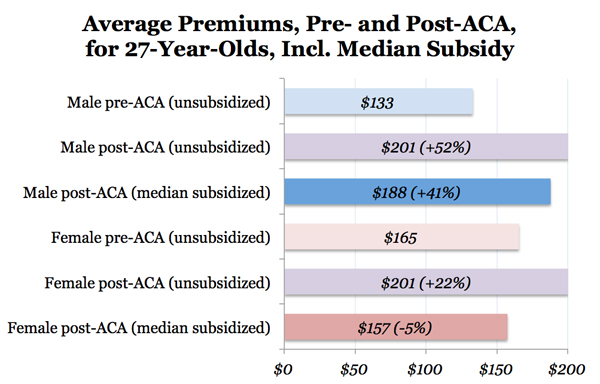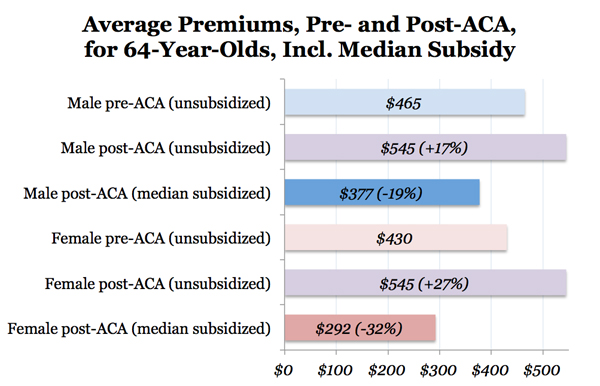49-State Analysis: Obamacare To Increase Individual-Market Premiums By Average of 41 Percent
From Forbes.com
 By Avik Roy
By Avik Roy
Forbes
One of the fundamental flaws of the Affordable Care Act is that, despite its name, it makes health insurance more expensive. Today, the Manhattan Institute released the most comprehensive analysis yet conducted of premiums under Obamacare for people who shop for coverage on their own. Here’s what we learned. In the average state, Obamacare will increase underlying premiums by 41 percent. As we have long expected, the steepest hikes will be imposed on the healthy, the young, and the male. And Obamacare’s taxpayer-funded subsidies will primarily benefit those nearing retirement—people who, unlike the young, have had their whole lives to save for their health-care needs.

41 states, plus D.C., will experience premium hikes
If you’ve been following this space, you know that I and two of my Manhattan Institute colleagues—Yevgeniy Feyman and Paul Howard—have developed an interactive map where you can see how Obamacare affects premiums in your state. (If you ever need to find it, simply Google “Obamacare cost map.”)
In September, we released the first iteration of the map, which included data from 13 states and the District of Columbia. We only had data from a few mostly-blue states because the remainder were mostly participating in the federal exchange, and the federal exchange—for reasons we now understand more fully—hadn’t released any premium information at that time. That analysis found that underlying premiums would increase by 24 percent in those 13 states plus D.C.
Obamacare’s supporters argue that these rate increases aren’t important, because many people will be protected from them by federal subsidies. Those subsidies aren’t free—they’re paid for by taxpayers–and so it is irresponsible for people to argue that subsidies somehow make irrelevant the underlying cost of health insurance. Nonetheless, it’s important to understand the impact of subsidies on Obamacare’s exchanges; later in September, we released a second iteration of the map to do just that.
Today’s release, with the third iteration of the map, contains both premium and subsidy data for every state except Hawaii. (Believe it or not, we’ve had success mining data from every exchange website but Hawaii’s.) This nearly-complete analysis finds that the average state will face underlying premium increases of 41 percent. Men will face the steepest increases: 77, 37, and 47 percent for 27-year-olds, 40-year-olds, and 64-year-olds, respectively. Women will also face increases, but to a lesser degree: 18%, 28%, and 37% for 27-, 40-, and 64-year-olds.
Biggest winners: NY, CO, OH, MA; Biggest losers: NV, NM, AR, NC
Eight states will enjoy average premium reductions under Obamacare: New York (-40%), Colorado (-22%), Ohio (-21%), Massachusetts (-20%), New Jersey (-19%), New Hampshire (-18%), Rhode Island (-10%), and Indiana (-3%). Most, but not all, of these states had heavily-regulated individual insurance markets prior to Obamacare, and will therefore benefit from Obamacare’s subsidies, and especially its requirement that everyone purchase health insurance or pay a fine.
The eight states that will face the biggest increases in underlying premiums are largely southern and western states: Nevada (+179%), New Mexico (+142%), Arkansas (+138%), North Carolina (+136%), Vermont (+117%), Georgia (+92%), South Dakota (+77%), and Nebraska (+74%).
If you’re interested in more details about our methodology, you can find them here. As with our past work, we calculated an average of the five least-expensive plans in every county in a state pre-Obamacare, adjusted to take into account those with pre-existing conditions and other health problems. We then did the same calculation with the five least-expensive plans in every county in the Obamacare exchanges. We then used these county-based numbers to come up with a population-weighted state average pre- and post-Obamacare.
Exchange plans narrow your choice of doctor, despite higher costs
The key thing to understand about our before-and-after comparison is that it is an average. If you’re healthy today, you will face steeper rate increases than these figures indicate. If you have a serious medical condition, however, and haven’t been able to find affordable health coverage as a result, you will do much better under Obamacare than the average person. Men will face steeper increases than women in most states, because women consume more health care than men do, and Obamacare forbids insurers to charge different prices on the basis of gender.
In addition, our comparison ignores other differences between pre-Obamacare and post-Obamacare plans. For example, in some cases, people looking for comparably-priced coverage on the exchanges will need to accept higher deductibles and other cost-sharing arrangements.
Importantly, post-Obamacare exchange plans will typically have narrow networks of physicians and hospitals, especially excluding those tied to prestigious medical schools. In today’s Wall Street Journal, Edie Sundby, who struggles with gallbladder cancer, argues that her pre-Obamacare access to leading academic cancer centers like Stanford has “kept me alive,” and notes that the plans available to her on the exchange don’t allow her to keep her doctor.

Elderly will receive massive subsidies, thanks to younger people
Thanks to community rating, a key feature of Obamacare, insurers are only allowed to charge their oldest customers three times the amount they charge their youngest customers. Because 64-year-olds consume on average six times as much health care as 19-year-olds, this rule has the effect of driving up the cost of insurance for young people.
But there’s a double whammy. Because premiums for those nearing retirement can still be three times higher than those of younger Americans, elderly individuals will disproportionately benefit from Obamacare’s subsidies. The subsidies increase in proportion to the percentage of your income that is tied up in health insurance; for elderly people whose premiums are much higher, the subsidies are higher too.
And when I say young people, I particularly mean young men. A young woman of average income in the average state will experience little net change in premium costs, if you take subsidies into account; 40-year-old women will see an average increase of 9 percent, and 27-year-old women will see an average decrease of 5 percent. (However, as I noted above, women in good health will see meaningfully higher increases than these averages reflect.)
Let’s take the two extremes. If you’re a 27-year-old man, your average premium under our methodology, pre-Obamacare, is $133 a month. Post-Obamacare, that increases to $201. If you add in the subsidies that accrue to someone with the median income of a 27-year-old man, the net cost of Obamacare insurance goes down slightly to $188. That’s a 41 percent increase, despite the impact of subsidies.
If you’re a 64-year-old woman, on the other hand, your average pre-Obamacare premium was $430 a month. Post-Obamacare, the underlying premium increases to $545 a month. But when you factor in subsidies for the average 64-year-old woman, the net cost of Obamacare insurance drops to $292. That’s a 32 percent decrease, inclusive of subsidies, from pre-Obamacare premiums, and a 46 percent discount off of post-Obamacare prices.
The irony is that, in 2012, younger voters overwhelmingly supported President Obama, while older voters backed Mitt Romney. Obamacare, in the average state, is a massive transfer of wealth from the young to the old.

This all assumes, of course, that the exchanges eventually work
Right now, the headlines are dominated with stories about the deep and thorough dysfunction of the federally-built Obamacare insurance exchange. It’s a serious problem. If the exchanges aren’t fixed soon, the likely outcome is that older, sicker, and poorer people sign up, while everyone else goes without coverage. That, in turn, will imbalance the insurance pool in the exchanges, making its products more expensive and subsidy-dependent. Those facing cancellation of their existing coverage face the greatest risk under the worst-case scenario.
But there is a best-case scenario, especially from the standpoint of the law’s supporters. It’s that the exchanges eventually get fixed, and turn out to be popular, even among the young men—the “bros”—who bear the steepest costs under the new system. If they do, not only will Obamacare be here to stay, but the law could end up evolving into an effective replacement for our older, single-payer health-care entitlements, Medicare and Medicaid.
From where we stand today, unfortunately, there is no reason to believe that the Obama administration has a handle on the problems with the federal exchange. Young men seem no more likely to buy a costlier insurance product than they were to buy one, pre-Obamacare, that was more affordable. And so we should remain concerned about the likelihood of the law’s ultimate success.



Leave a Reply
Want to join the discussion?Feel free to contribute!